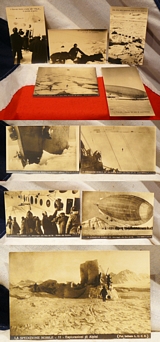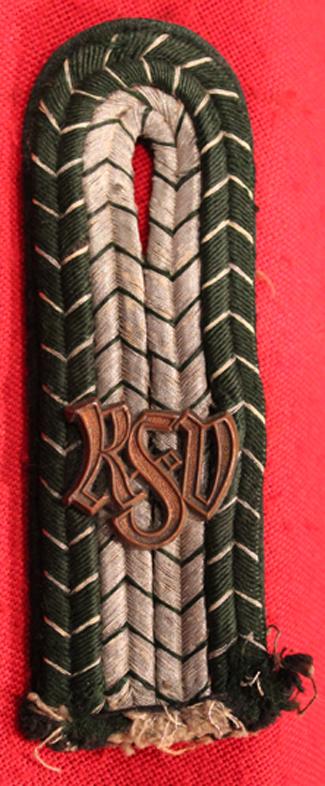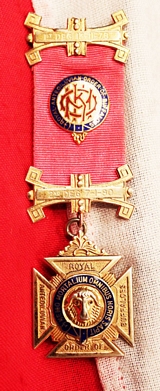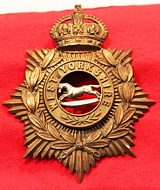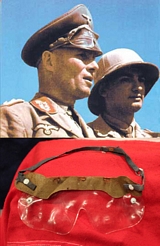WW1 / WW2 / 20th Century
Original WW1 Gurkha's Kukri Field Marshall Manekshaw once said, " If someone says he does not fear death, then he is either telling a lie or he is a Gurkha".
Part of a collection of 3 original military Gurkha's kukri, two WW2 and one WW1 and a WW2 Japanese soldiers flag {now sold}. All without scabbards, with very good blade with signs if combat use and surface marking and some areas of old pitting. They were all formerly on display on the walls of a defunct in 1968 regimental officer's mess the Royal Warwickshire Regt, moved when it merged in 1968 to become Fusilier Brigade with a WW2 Japanese silk flag. All 4 pieces are being sold by us separately. Tempered steel blade and carved wood hilt. The Kukri is the renown and famous weapon of the Nepalese Gurkha.A Superb WW1 Gurkha's Kukri Combat Knife "Ayo Gorkali" The Gurkha Battle Call "The Gurkhas Are Coming!" Field Marshall Manekshaw once said, " If someone says he does not fear death, then he is either telling a lie or he is a Gurkha". The Gukhas are the finest and bravest, combat soldiers in the world, with legendary loyalty to the British Crown. When worn in combat it would normally be in a khaki canvas cover. Superb tempered steel blade, overall in fabulous condition. Field Marshall Sam Manekshaw once said, " If someone says he does not fear death, then he is either telling a lie or he is a Gurkha". On 12/13 May 1945 at Taungdaw, Burma now Myanmar, Rifleman Lachhiman Gurung VC was manning the most forward post of his platoon which bore the brunt of an attack by at least 200 of the Japanese enemy. Twice he hurled back grenades which had fallen on his trench, but the third exploded in his right hand, blowing off his fingers, shattering his arm and severely wounding him in the face, body and right leg. His two comrades were also badly wounded but the rifleman, now alone and disregarding his wounds, loaded and fired his rifle with his left hand for four hours, calmly waiting for each attack which he met with fire at point blank range. Afterwards, when the casualties were counted, it is reported that there were 31 dead Japanese around his position which he had killed, with only one arm.In the Falklands War in 1982 the Argentinians abandoned Mount William without a fight simply because the enemy forces advancing towards them were the 2nd Battalion, 7th Ghurka Rifles. Probably the most respected and feared warriors in the world, the Gurkhas of Nepal have fought in the Gurkha regiments of the British Army for around two centuries. With a degree of loyalty and dedication that is legendary, there is no greater soldier to be at one's side when in battle than the noble Gurkha. With a Kukri in his hand and the battle cry called, "Ayo Gorkhali!" "the Gurkhas are coming!", no foe's head was safe on his shoulders. Battle hardened German Infantry in WW1, or WW2 Japanese Shock Troops, have been known to tremble in their boots at the knowledge that they would be facing the Gurkhas in battle. Some of the most amazing feats of heroism have resulted in the most revered medal, the British Victoria Cross the world's greatest and most difficult to qualify for gallantry medal being awarded to Ghurkas. The blade shape descended from the classic Greek sword of Kopis, which is about 2500 years old.
Some say it originated from a form of knife first used by the Mallas who came to power in Nepal in the 13th Century. There are some Khukuris displaying on the walls of National Museum at Chhauni in Kathmandu which are 500 years old or even older, among them, one that once belonged to Drabya Shah, the founder king of the kingdom of Gorkha, in 1627 AD. But, some say that the Khukuri's history is possibly centuries older this. It is suggested that the Khukuri was first used by Kiratis who came to power in Nepal before Lichchhavi age, in about the 7th Century. In the hands of an experienced wielder Khukuri or Kukri is about as formidable a weapon as can be conceived. Like all really good weapons, Khukuri's or Kukri's efficiency depends much more upon skill than the strength of the wielder. And thus so that it happens, that a diminutive Gurkha, a mere boy in regards to his stature, could easily cut to pieces a gigantic adversary, who simply does not understand the little Gurkha's mode of attack and fearsome skill. The Gurkha generally strikes upwards with his Kukri, possibly in order to avoid wounding himself should his blow fail, and possibly because an upward cut is just the one that can be least guarded against however strong his opponent. Approx 18.5 inches long read more
295.00 GBP
A Rare Set of Spare Parts For A German WW2 Panzer Binocular Gun Sight
With excellent lenses.
Ideal for the collector of WW2 German military opticals, perfect as spares or for replacing lost or damaged parts. They would cost many, many times the price we ask to re manufacture, if they could even be replicated today, and may not be needed now, but to save them in case of need one day, would be exceptionally prudent and sound logic.
They could also be perfect for a collector of German WW2 Panzer military equipment at relatively minute cost.
Photo 3 in the gallery shows a complete binocular with the parts we offer in place
The beauty of these parts is that they are universal fit, even though they came from a panzer case originally they would fit kriegsmarine gun sights and luftwaffe anti aircraft sights read more
175.00 GBP
A Zeppelin Airship Post Letter, For Flight Returning to Berlin for The 1936 Olympics, on the Brazil to Germany Flight, 27 July 1936
A South American Europe Flight, the Hindenberg’s 31st flight, arrived back from Rio to Frankfurt flight and flew to arrive above Berlin at the Olympic Stadium on the 1st August the Olympics of 1936. Superb condition envelope and franked stamps.
The Hindenburg Zeppelin flew over the Olympic Arena, on the 1st of August, and the envelope was date stamped just a few days before on the 27th, midway on its journey from Brazil back to Germany, returning in order to fly at the Olympic Games opening ceremony.
The Berlin Games are best remembered for Adolf Hitler’s failed attempt to use them to prove his theories of Aryan racial superiority. As it turned out, the most popular hero of the Games was the African-American sprinter and long jumper Jesse Owens, who won four gold medals in the 100m, 200m, 4x100m relay and long jump.
Television Coverage
The 1936 Games were the first to be broadcast on television. Twenty-five television viewing rooms were set up in the Greater Berlin area, allowing the locals to follow the Games free of charge.
Young Olympians
Thirteen-year-old Marjorie Gestring of the U.S. won the gold medal in springboard diving. She remains the youngest female gold medallist in the history of the Summer Olympic Games. Twelve-year-old Inge Sorensen of Denmark earned a bronze medal in the 200m breaststroke, making her the youngest medallist ever in an individual event.
Debuts and Firsts
Basketball, canoeing and field handball all made their first appearances
The Hindenburg made 17 round trips across the Atlantic in 1936, its first and only full year of service, with ten trips to the United States and seven to Brazil. In July 1936 it completed a record Atlantic double crossing in five days, 19 hours and 51 minutes. Among the famous passengers was German heavyweight boxing champion Max Schmeling, who returned home on the Hindenburg to a hero's welcome after knocking out Joe Louis in New York on June 19, 1936. During the 1936 season the airship flew 191,583 miles (308,323 km), carried 2,798 passengers, and transported 160 tons of freight and mail, a level of success that encouraged the Luftschiffbau Zeppelin Company to plan the expansion of its airship fleet and transatlantic service.
The airship was reportedly so stable that a pen or pencil could be stood on a table without falling. Its launches were so smooth that passengers often missed them, believing that the airship was still docked to its mooring mast. The cost of one way passage between Germany and the United States was US$400, an especially considerable sum in the Depression era. Hindenburg passengers were generally affluent, including many public figures, entertainers, noted sportsmen, political figures, and leaders of industry.
The Hindenburg was used again for propaganda purposes when it flew over the Olympic Stadium in Berlin on August 1 during the opening ceremonies of the 1936 Summer Olympic Games. Shortly before the arrival of Adolf Hitler to declare the Games open, the airship crossed low over the packed stadium while trailing the Olympic flag on a long weighted line suspended from its gondola.
During 1936 the Hindenburg had a special Bl?thner aluminium grand piano placed on board in the music salon, although the instrument was removed after the first year to save weight. Over the winter of 1936?37, several alterations were made to the airship's structures. The greater lift capacity allowed ten passenger cabins to be added, nine with two beds and one with four beds, thus increasing the total passenger capacity to 72. In addition, "gutters" were installed to collect rain for use as water ballast: taking on rainwater ballast to compensate for the weight of fuel consumed during a voyage was more economical than venting hydrogen.
Another change was the installation of an experimental aircraft hook-on trapeze based on the system similar to the one used on the U.S. Navy Goodyear-Zeppelin built airships Akron and Macon. This was intended to allow customs officials to be flown out to the Hindenburg to process passengers before landing and to retrieve mail from the ship for early delivery. Experimental hook-ons and takeoffs were attempted on March 11 and April 27, 1937, but were not very successful, owing to turbulence around the area where the hook-up trapeze had been mounted. The loss of the ship ended all prospects of further testing. read more
375.00 GBP
A Most Rare Set Of 12 Original Photographs Of The General Nobile 1928 Polar Airship Expedition
Original Polar Expeditions collectables are most highly desirable and we have been delighted to acquire two such connected lots. These are 12 original photographic postcards, published at the time, by two publishers, Traldi and Ballerini & Fratini. For example one is entitled "La Spedizione Nobile - 11 - Esplorazioni di Alpini."
Ed. A. Traldi, Milan, n.d. c. 1928. and another "General Nobile to edge of Italy before leaving."
Umberto Nobile January 21, 1885 ? July 30, 1978) was an Italian aeronautical engineer and Arctic explorer. Nobile was a developer and promoter of semi-rigid airships during the Golden Age of Aviation between the two World Wars. He is primarily remembered for designing and piloting the airship Norge, which may have been the first aircraft to reach the North Pole, and which was indisputably the first to fly across the polar ice cap from Europe to America. Nobile also designed and flew the Italia, a second polar airship; this second expedition ended in a deadly crash and provoked an international rescue effort.The N-class airship Italia was slowly completed and equipped for Polar flight during 1927-28. Part of the difficulty was in raising private funding to cover the costs of the expedition, which finally was financed by the city of Milan; the Italian government limited its direct participation to providing the airship and sending the aging steamer Citt? di Milano as a support vessel to Svalbard, under the command of Giuseppe Romagna.
This time the airship used a German hangar at Stolp en route to Svalbard and the mast at Vads? (Northern Norway). On May 23, 1928, after an outstanding 69 hour long flight to the Siberian group of Arctic islands, the Italia commenced its flight to the North Pole with Nobile as both pilot and expedition leader. On May 24, the ship reached the Pole and had already turned back toward Svalbard when it ran into a storm. On May 25, the Italia crashed onto the pack ice less than 30 kilometres north of Nordaustlandet (Eastern part of Svalbard). Of the 16 men in the crew, ten were thrown onto the ice as the gondola was smashed; the remaining six crewmen were trapped in the buoyant superstructure as it ascended skyward due to loss of the gondola; the fate of the six men was never resolved. One of the ten men on the ice, Pomella, died from the impact; Nobile suffered a broken arm, broken leg, broken rib and head injury; Cecioni suffered two badly broken legs; Malmgren suffered a severe shoulder injury and suspected injury to a kidney; and Zappi had several broken ribs.
The crew managed to salvage several items from the crashed airship gondola, including a radio transceiver, a tent which they later painted red for maximum visibility, and, critically, packages of food and survival equipment which quick-witted engineer Ettore Arduino had managed to throw onto the ice before he and his five companions were carried off to their deaths by the wrecked but still airborne airship envelope and keel. As the days passed, the drifting sea ice took the survivors towards Foyn and Broch islands.
A few days after the crash the Swedish meteorologist Malmgren and Nobile's second and third in command Mariano and Zappi decided to leave the immobile group and march towards land. Malmgren, who was injured, weakened and reportedly still depressed over his meteorological advice that he felt contributed to the crash, asked his two Italian companions to continue without him. These two were picked up several weeks later by the Soviet icebreaker "Krasin". However there were persistent rumors that Malmgren was killed and cannibalized by Zappi and Mariano
They would look incredible suitably bespoke framed [with UV protected glass] read more
675.00 GBP
Greek War Medal 1940-41, Greek Italian War, Battle of Crete
Awarded to Greek and Allied forces that fought agianst the Germans in Crete Battle of Crete 1941 and in Albania, Macedonia, Thrace and Epirus against the Italians.
The Battle of Crete (German: Luftlandeschlacht um Kreta, also Unternehmen Merkur, "Operation Mercury", Greek: Μάχη της Κρήτης) was fought during the Second World War on the Greek island of Crete. It began on the morning of 20 May 1941, when Nazi Germany began an airborne invasion of Crete. Greek and other Allied forces, along with Cretan civilians, defended the island. After only one day of fighting, the Germans had suffered heavy casualties and the Allied troops were confident that they would defeat the invasion. The next day, through communication failures, Allied tactical hesitation, and German offensive operations, Maleme Airfield in western Crete fell, enabling the Germans to land reinforcements and overwhelm the defensive positions on the north of the island. Allied forces withdrew to the south coast. More than half were evacuated by the British Royal Navy and the remainder surrendered or joined the Cretan resistance. The defence of Crete evolved into a costly naval engagement; by the end of the campaign the Royal Navy's eastern Mediterranean strength had been reduced to only two battleships and three cruisers.
The Battle of Crete was the first occasion where Fallschirmjäger (German paratroops) were used en masse, the first mainly airborne invasion in military history, the first time the Allies made significant use of intelligence from decrypted German messages from the Enigma machine,and the first time German troops encountered mass resistance from a civilian population. Due to the number of casualties and the belief that airborne forces no longer had the advantage of surprise, Adolf Hitler became reluctant to authorise further large airborne operations, preferring instead to employ paratroopers as ground troops. In contrast, the Allies were impressed by the potential of paratroopers and started to form airborne-assault and airfield-defence regiments. read more
WW2 Third Reich Customs Officials Shoulder Board
A WW2 Third Reich Customs (Zoll) Official epaulette. The Green & silver epaulette with silver and green inner sections, on a green wool field. Metal 'RZD' (Reichszolldienst) monogram .Zollgrenzschutz (ZGS) (lit. 'Customs Border Guards') was an organization under the German Finance Ministry from 1937 to 1945. It was charged with guarding Germany's borders, acting as a combination Border Patrol and Customs & Immigration service.
In Nazi Germany it was formed in 1937 by Fritz Reinhardt, a State Secretary of the Finance Ministry. It came to comprise about 50,000 officials. The Border Police (Grenzpolizei), which had the tasks of passport and border control, was different from the Customs Border Guards (Zollgrenzschutz).
Heinrich Himmler tried to bring the Zollgrenzschutz under the control of the Schutzstaffel (SS), which was unsuccessful at first. During the war, the units were used in occupied territories outside of Germany. A significant portion of younger officials were recruited to the Wehrmacht, leaving the Zollgrenzschutz with older men. After the 20 July 1944 assassination attempt on Hitler, the units were taken out of the control of the Finance Ministry and placed under Amt IV (Gestapo) of the Reich Security Main Office (RSHA)
Photo in the gallery of Oberzollrat of the Zollgrenzschutz [far left] with Field Marshal Ernst Rommel [middle] read more
45.00 GBP
A Superb, Solid Silver Gilt and Enamel Royal Antediluvian Order Of Buffaloes Order Of Merit
Hallmarked silver with fine mint enamelling and silk ribbon, known within the order as a jewel. The Royal Antediluvian Order of Buffaloes (RAOB) was one of the largest fraternal organisations in the United Kingdom. The order started in 1822 and is known as the Buffs to members.
The RAOB organisation aids members, their families, dependents of former members and other charitable organisations. The order has a Rule Book, Manual of Instruction and Ceremony Lectures issued and revised by the Grand Lodge of England based at Harrogate in England. The 'lodge' description for branch organisation and headquarters was adopted in imitation of Freemasonry but RAOB is completely open in its objectives, activities and ritual. The RAOB was begun in the Harp Tavern (opposite the Drury Lane Theatre) by the artist Joseph Lisle and comedian William Sinnett along with other stage hands and theatre technicians in August 1822. It drew its then name of The Buffaloes from a popular song of the time We?ll chase the Buffalo. This first meeting is historically the Phoenix Lodge No.1. As members toured the country with various shows lodges were opened in other towns.
The Order's motto "No Man Is At All Times Wise" (Latin: Nemo Mortalium Omnibus Horis Sapit) and has the maxim of "Justice, Truth and Philanthropy". read more
95.00 GBP
Rare, Complete and Original, Triumph Magazine Portfolio of Flying
Original 1930's issue. Softcover, in exceellent condition, about 3.5 x 5.25 inches but folds out to about 14 x 5.25 inches, folds out to 4 panels with each panel have two small booklets (about 3 x 2 inches each), each booklet contains 7 small b&w photos or illustrations, the booklets are as follows: Queer Aircraft ( glider plane; Westland-Hill Pterodactyl 3 seater; Northrop Beta monoplane; Focke Wulf; Cierva autogiro; seaplane; mono-spar 3 seater ), ---All in a Days Flying ( iceberg patrol; aerial mountie gets his man; stemming the stampede; answering an SOS; Air Mail; the flying shop (delivering goods to natives); rescuing stranded mountaineers ) ---Trail Blazers of the Air ( Charles Lindbergh; Richard Byrd; J A Mollison; Charles Kingsford-Smith; Bert Hinkler; Amy Johnson; Alan Cobham ) ---Stunting in Space ( wing walkers, acrobats, dare devils; etc ) ---War Hawks ( a zeppelin hunter; machine gunning the artillery; dog fight; British blimp bombs a submarine; destroying an observation balloon; etc) ---Great Gas Bags ( the Graf zeppelin; Picard's Stratosphere balloon; USS Akron; jumping balloon; Spanish observation balloon; American airship moored; a plane carrying airship ) ----Guardians of the Empire's Airways ( fighter taking off from aircraft carrier Furious; 20 ton RAF monoplane; Blackburn Napier torpedo plane; desert patrol; loading a bomber; getting an RAF searchlight ready; catapulting a plane from a submarine ) ---Planes of all Nations ( Belgian fighter; british 38 seaterand Puss Moth; French Paris to London liner; Italian S.55 flying boat; Junker; Swiss Dornier Do-X; American military transport plane ), read more
140.00 GBP
An Edwardian West Yorkshire Regt. Large Helmet Plate
World War I saw numerous battalions of The Prince of Wales's Own (West Yorkshire Regiment) serving at Neuve-Chappelle, Loos, the Somme, Passchendaele, Ypres, Marne, Arras, Cambrai and Gallipoli. At its peak The West Yorkshire Regiment numbered 37 battalions, 66 Battle Honours were bestowed and four Victoria Crosses were awarded.
The four TF battalions formed the West Yorkshire Brigade, which mobilised as 146 Brigade, 49th (West Riding) Infantry Division on the outbreak of World War I and served in France 1915?18. They raised duplicate battalions (2/5th, 2/6th, 2/7th, 2/8th) that constituted 185 Bde in 62nd (2nd West Riding) Division, which also served in France 1917?18. In 1915 they formed further reserve battalions (3/5th, 3/6th, 3/7th, 3/8th) Battle honours in WW1 The Great War [31 battalions]: Aisne 1914 '18, Armenti?res 1914, Neuve Chapelle, Aubers, Hooge 1915, Loos, Somme 1916 '18, Albert 1916 '18, Bazentin, Pozi?res, Flers-Courcelette, Morval, Thiepval, Le Transloy, Ancre Heights, Ancre 1916, Arras 1917 '18, Scarpe 1917 '18, Bullecourt, Hill 70, Messines 1917 '18, Ypres 1917 '18, Pilckem, Langemarck 1917, Menin Road, Polygon Wood, Poelcappelle, Passchendaele, Cambrai 1917 '18, St. Quentin, Rosi?res, Villers Bretonneux, Lys, Hazebrouck, Bailleul, Kemmel, Marne 1918, Tardenois, Amiens, Bapaume 1918, Drocourt-Qu?ant, Hindenburg Line, Havrincourt, ?p?hy, Canal du Nord, Selle, Valenciennes, Sambre, France and Flanders 1914-18, Piave, Vittorio Veneto, Italy 1917-18, Suvla, Landing at Suvla, Scimitar Hill, Gallipoli 1915, Egypt 1915-16 read more
220.00 GBP
A Pair of WW2 Gas Shield Eye Protectors, Afrika Korps Dessert Campaign Souvenirs, 'Rommel' Type
Made for the British forces in the earliest part of the war, initially as gas protectors, but actually soon realised to be far better as sand storm eye protection, made of an early form of clear celluloid with elastic.
Used to great effect by our so-called Desert Rats in North Africa, but many were captured in the early part of the war in Afrika by the German forces, and re-issued and used by them. In fact Rommel used the very same protectors for that purpose as one can see from the numerous photos of Rommel taken in Africa.
Part of a collection of Afrika Korps campaign souvenirs, including the tinted celluoid goggle type, and a complete pack of goggles, in all original packing, very rare to survive complete packet and contents read more
55.00 GBP





